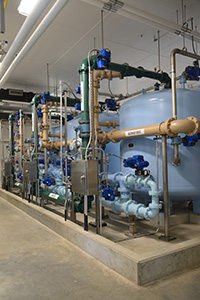 Our water system uses groundwater wells to supply water for our customers. The water undergoes a variety of treatment processes to improve its quality in order to meet drinking water regulations.
Our water system uses groundwater wells to supply water for our customers. The water undergoes a variety of treatment processes to improve its quality in order to meet drinking water regulations.
The first process is natural filtration through the sand and gravel deposits near the wells. As water travels from the land surface towards the wells, the naturally occuring sand and gravel deposits filter out many contaminants including coliform bacteria, vegetative debris, and others that are commonly found on the surface of the ground or in nearby surface water bodies.
Once the water is in our supply system it travels to the water treatment plant for additional treatment including disinfection, pH adjustment, greensand filtration, aeration, fluoridation and sequestration/corrosion control. The raw water is treated in the following order:
- Sodium Hypochlorite Pre-treatment: Chlorine is added to the water as it arrives in the plant disinfect the water. Chlorine is also an essential component of greensand filtration becuase it is the primary oxidant used to remove manganese. The pre-filtered water typically has a free chlorine residual of around 0.75 milligrams/L (mg/L).
- Pre-treatment pH Adjustment: The pH or acidity of the water is reduced prior to filtration. The pH of the raw water, normally around 6.5-6.6, is raised to 6.9 using potassium hydroxide.
- Potassium Permanganate Pre-treatment: We have the option of using potassium permanganate to oxidize the manganese but it is not in use at this time.
- Greensand Filtration: The water is passed through filter vessels with a layered media including anthracite, Greensand Plus and gravel. The Greensand Plus traps any manganese in particulate or soluble form and removes it from the water. This step also removes iron but we typically have very little to no iron in the water.
- Aeration: The water is pumped through an aerator which strips out carbon dioxide to reduce the amount of dissolved inorganic carbon and further increase the pH of the water from 6.9 to 7.5. This step improves corrosion control and raises the pH without chemical addition.
- Fluoridation: Once out of the aerator, fluoride is added to the water to maintain a level of 0.7 mg/L of fluoride. This step is intended to prevent tooth decay.
- Pre-clearwell Disinfection: We have the option of adding more chlorine before the water enters the clearwell.
- Clearwell: The water enters a baffled clearwell arrangement that provides more contact time for the disinfection process. This allows us to produce water that has a lower and more stable chlorine residual when it leaves the plant.
- Post-treatment pH adjustment: We have the option of increasing the pH of the water just before it leaves the plant. This is not currently used but will be required when the aerator is undergoing maintanence.
- Phosphate: A ortho/poly-phosphate blend is added to the water as it leaves the plant. This formulation was used to sequester manganese but also has corrosion control benefits.
